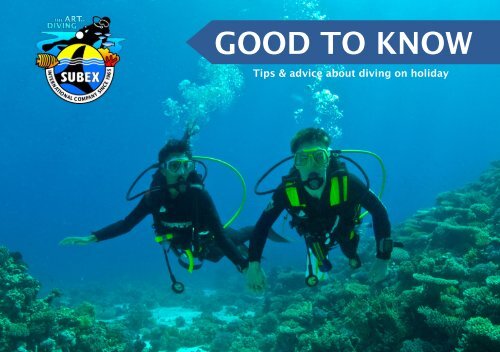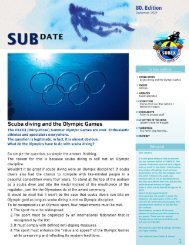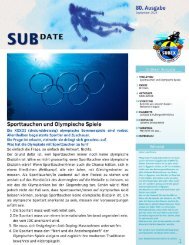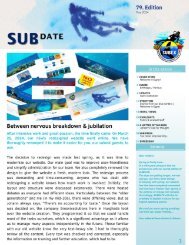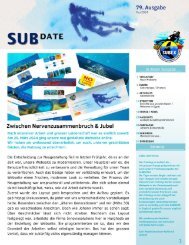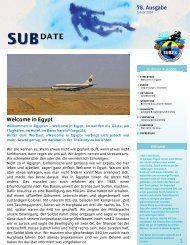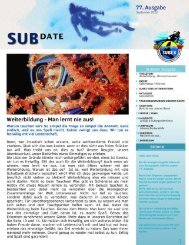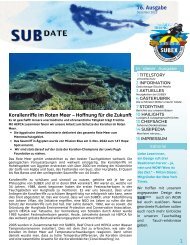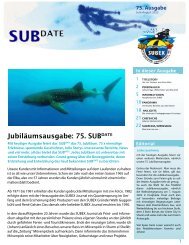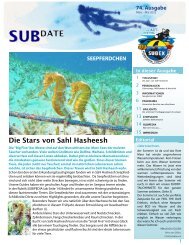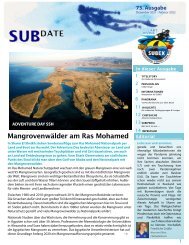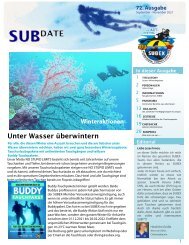GOOD TO KNOW
In the new brochure "Good to know", the renowned Swiss diving school SUBEX gives tips and advice for a perfect diving holiday. All important diving holiday preparations, which start with a good planning including the careful selection of the destination and dive center, are described in detail by the author Johann Vifian and with enormous background knowledge. The innovative "diving holiday checklist" helps, for example in the process of distinguishing good dive centers in advance from dubious ones so that negative surprises can be avoided on the spot. Extensive practical tips on dives and diving equipment will be discussed as well as environmentally conscious diving and training. The included overview of the training levels of the various diving sports organizations and associations (CMAS, SSI and PADI) is particularly enlightening. Fascinating, taken by the author himself, pictures illustrate and underline the informative valuable content.
In the new brochure "Good to know", the renowned Swiss diving school SUBEX gives tips and advice for a perfect diving holiday.
All important diving holiday preparations, which start with a good planning including the careful selection of the destination and dive center, are described in detail by the author Johann Vifian and with enormous background knowledge. The innovative "diving holiday checklist" helps, for example in the process of distinguishing good dive centers in advance from dubious ones so that negative surprises can be avoided on the spot.
Extensive practical tips on dives and diving equipment will be discussed as well as environmentally conscious diving and training. The included overview of the training levels of the various diving sports organizations and associations (CMAS, SSI and PADI) is particularly enlightening.
Fascinating, taken by the author himself, pictures illustrate and underline the informative valuable content.
Create successful ePaper yourself
Turn your PDF publications into a flip-book with our unique Google optimized e-Paper software.
<strong>GOOD</strong> <strong>TO</strong> <strong>KNOW</strong><br />
Tips & advice about diving on holiday
Content<br />
1. Foreword<br />
2. Practical tips for holiday divers<br />
3. Diving holiday preparation<br />
4. Diving at the resort<br />
5. Environmentally-conscious diving<br />
6. Diving organizations and associations<br />
7. Continuing education<br />
8. On our own behalf
Foreword<br />
“Good to know” is better than “If I had only known.” This applies to your dives as well<br />
as to your dive holiday. Proper preparation is essential to a successful dive holiday<br />
with memorable, unique, and safe dives. For this reason, we have created the <strong>GOOD</strong><br />
<strong>TO</strong> <strong>KNOW</strong> resource.<br />
Best regards<br />
Johann Vifian<br />
Four decades of experience as co-owner and manager of dive centers, top-level<br />
instructor and dive guide with thousands of dives.
Keep an eye out, because<br />
vacation time is precious!<br />
2. Practical tips for holiday divers<br />
4<br />
The more careful the preparation, the better the result,<br />
especially when it comes to a dive holiday.<br />
The perfect dive holiday is made up of various elements, each<br />
of which should be given attention during preparation.<br />
Everything starts with the advance planning of the dive trip.<br />
Preparation for the dive itself then begins on the spot.<br />
The dive itself, with a corresponding detailed debriefing, is as<br />
important as security and environmental awareness for an<br />
ideal dive holiday.<br />
Continuing education courses, as well as knowledge about<br />
diving associations, supplement diving know-how.<br />
If your goal is a logbook full of superlative entries and<br />
unforgettable memories of a thoroughly successful dive<br />
holiday, it’s worth spending a lot of time and energy on<br />
preparation.
Choosing the destination<br />
3. Diving holiday preparation<br />
Individual factors such as the available<br />
budget, available holiday time, dive<br />
experience, and accompanying diving or<br />
non-diving partners/family members largely<br />
determine the choice of holiday destination.<br />
Above-water activities, e.g. wellness,<br />
alternative sports and leisure activities,<br />
entertainment, culture, etc. can be<br />
included as well as the expectations about<br />
accommodation (guest house, hotel,<br />
holiday resort, club facilities, etc.).<br />
All these factors must be considered and<br />
should meet the needs of all travelers.<br />
In any case, no matter the final destination,<br />
a dive holiday starts at the planning stage<br />
at home.<br />
The sooner the better!<br />
Vacation time is valuable, and negative<br />
surprises can be avoided with proper<br />
preparation.<br />
5
Tips for selecting the diving destination<br />
After evaluating individual needs and factors, the next step is to<br />
search and find the holiday location.<br />
Internet research to separate the wheat from the chaff is essential.<br />
Descriptions that promise the moon are to be treated with caution. It<br />
is better to look for measurable and thus comparable facts.<br />
Again, it cannot be pointed out often enough that the more time<br />
spent on the research, the greater the chance that the holiday will be<br />
a complete success.<br />
Many factors have to be considered and checked. Here, they are<br />
divided into four categories:<br />
Holiday duration<br />
The shorter the holiday, the closer the destination should be. It’s<br />
impractical and financially illogical to take a faraway, expensive trip<br />
that lasts only 7 to 10 days. The money can be better invested in<br />
diving. For travel to more distant destinations, schedule at least 14 to<br />
21 days.<br />
Season<br />
How are the seasonal weather conditions at my proposed travel time,<br />
not just on land, but also in the water? Visibility, water temperature,<br />
wind conditions, sea state, and seasonal restrictions should all be<br />
considered. In which season are diving conditions ideal?<br />
6
Diving prerequisites, diving area and dive activities<br />
These key characteristics are important factors in finding<br />
and choosing of the diving destination.<br />
Do the dive sites and the dive activities correspond to<br />
my diving requirements?<br />
Each dive site can be classified into one of the three<br />
categories - easy (not demanding), average, and difficult<br />
(challenging).<br />
This applies to all destinations, whether in the Red Sea,<br />
the Philippines, or the Mediterranean. Everywhere there are<br />
attractive dive sites that correspond to your experience and<br />
desires.<br />
It is a misconception that an easy dive area is automatically<br />
unattractive and a more difficult one is more attractive.<br />
Often the opposite is the case! One thing is certain, diving<br />
beyond your skill level can turn a dream dive holiday into a<br />
nightmare. Often, less is truly more!<br />
As a guideline, the dive experience is relevant: Easy, less<br />
than 50 dives. Medium, 50 to 100 dives. Difficult, more<br />
than 100 dives.<br />
Recommendation for a dive safari/liveaboard: at least 50<br />
dives.<br />
The type of dive activity must also be considered:<br />
Are the dives carried out from land, with easy access<br />
and exit, or is transport required? If yes, which type<br />
of transport? Inflatable boat, dinghy and / or off-road<br />
vehicles?<br />
7 7
Wishes / requirements<br />
How often do you want to dive? Daily, as often and as much as possible?<br />
If so, then you can save money by choosing inexpensive accommodation.<br />
There is little point to spend money on accommodation with amenities that<br />
you cannot use because you are diving all day.<br />
Do you plan to participate in holiday activities other than diving?<br />
If yes, then search and select a corresponding destination.<br />
Will non-diving companions (partner, family) be traveling with you?<br />
Insure that the needs of the accompanying travelers are met, especially<br />
when choosing the hotel.<br />
Personal holiday preparation<br />
The earlier you start planning, the less stress you will have before your<br />
holiday.<br />
You can look online for general holiday checklists; as a diver, you should<br />
also consider the following:<br />
Do you have a doctor’s certificate from a recent dive physical? If not, then<br />
have one completed. If you are under 40, it should be less than two years<br />
old, and if you are over 40, it should be less than a year old. A template is<br />
available for download at www.subex.org/tu.pdf.<br />
Do you have your own dive equipment? ? If not, see under “Rent or buy<br />
diving equipment” (page 9), if so, check whether it still fits. Your buoyancy<br />
compensator (BCD) and regulator should be serviced annually by the dealer.<br />
Check your dive computer battery.<br />
Finally, your diving logbook and certification belong in your carry-on<br />
luggage, just like your passport.<br />
8
Choosing a dive center<br />
Once you’ve decided on a vacation destination, the<br />
most important point on the “To Do List” of your holiday<br />
preparation is next: Search and select a dive center.<br />
How to find the right dive base<br />
If you do not spend enough time on this, you will pay for it<br />
in the truest sense of the word. You will pay with frustration<br />
and anger at not getting what you wanted. Moreover, your<br />
holiday will be irrevocably lost; no one can give it back to<br />
you.<br />
To avoid this, you can use our two tools: Dive Center<br />
Checklist (free download on<br />
www.subex.org/dc.pdf) and Dive Info & Wishes (free download<br />
at www.subex.org/ti.pdf).<br />
On the Dive Center Checklist, all relevant points are listed as<br />
questions and can be answered with a simple YES or NO.<br />
Here you can find factors to consider when choosing the dive<br />
center and specific questions to ask in an email if you cannot<br />
find sufficient information on the website.<br />
“Dive Info & Wishes” contains all information you should give<br />
the dive center. When they are fully informed of your expectations,<br />
they can better answer your questions and cater to<br />
your needs.<br />
Note: When selecting the dive center, the cheapest price<br />
should not be the main criteria. Instead, evaluate the price/<br />
performance ratio—that is, how much and what quality you<br />
get for your money.<br />
Diving center<br />
checklist as a free<br />
download<br />
www.subex.org/dc.pdf<br />
9
Diving Equipment - rent or buy?<br />
If you only take a dive holiday once a year, carefully consider before purchasing<br />
a complete set of dive equipment. Why? Quite simply, the benefit should match<br />
the cost.<br />
Tips and hints for cost - benefit comparison<br />
• The more frequently and the longer you dive, the more experience you will<br />
have, and you will be able to assess better which equipment fits and suits you.<br />
• If you decide to buy, do so step by step, one piece of equipment at a time:<br />
• First, the snorkel set—a mask, fins, and snorkel: The advantage of your own<br />
snorkel set is that you can always use it “just” for snorkeling.<br />
Additionally, the snorkel set is relatively inexpensive, not difficult to find, and<br />
fits easily in your holiday luggage.<br />
•Next, the dive computer: At many dive centers, the dive computer is not part<br />
of a complete rental package and must be rented separately, at an additional<br />
cost.<br />
•Then, the wetsuit: The purchase of your own wetsuit is recommended if you<br />
have special size requirements, as not all dive centers will have these in stock.<br />
For standard dress sizes, you can borrow a suit on the spot. This means that<br />
you can always choose the appropriate neoprene thickness, and even if you have<br />
possibly lost or gained weight, you will find a suit that fits.<br />
• Finally, if at all, a buoyancy compensator (BCD) and regulator: The<br />
regulator must be serviced annually by an expert, which adds ongoing costs to<br />
the purchase price.<br />
A complete set of dive equipment weighs 15 to 20 kg. Fewer and fewer<br />
airlines carry baggage free of charge. Keep these potential costs in mind when<br />
considering whether to rent or buy.<br />
Note: Dive equipment should always be purchased from a dealer with sales<br />
advice and warranties.<br />
10
Let’s get in the water!<br />
4. Diving at the resort<br />
Arrived at last!<br />
Your dive holiday can begin! It can be divided into three<br />
phases: 1. Check-in 2. Diving 3. Check-out<br />
Consider the following tips:<br />
CHECK IN<br />
Schedule sufficient time for check-in, which should include the<br />
following points:<br />
• registration form<br />
• dive equipment<br />
• facilities<br />
• dive activities<br />
• prices/payment terms<br />
REGISTRATION FORM<br />
This should be in your native language, and you should read it<br />
carefully before you sign it. In any case, clarify any ambiguities<br />
with the dive center in advance. Show your logbook, certification<br />
card, and your fit-to-dive medical.<br />
11
DIVE EQUIPMENT<br />
Whether renting complete equipment or individual pieces, check that<br />
everything (wetsuit, fins, boots, mask, and BCD) fit well.<br />
The regulator unit should consist of the main regulator with an octopus/<br />
second regulator, a pressure gauge, and an inflator.<br />
A snorkel and dive computer complete the rental equipment set.<br />
If using your own regulator and/or BCD, ensure that the connections are<br />
compatible with the tank valves (DIN or INT).<br />
Adjust the girth of the BCD to the circumference of the tank.<br />
Ideally, both should be mounted on a tank for testing purposes, and a<br />
functional check should be performed (see page 16). Only then should<br />
you store equipment in the box or locker that is provided for you during<br />
your vacation.<br />
FACILITIES<br />
Take a guided tour that points out the dive center’s facilities and explains<br />
their uses. Where and how can you store equipment?<br />
Rinse tanks, dressing rooms, restrooms, vehicles, classrooms, recreation<br />
areas, and, in particular, safety equipment should be included in the tour.<br />
The emergency equipment, including oxygen demand system, must be<br />
taken along on all excursions.<br />
Where is the meeting place for house dives or from where does transport<br />
to dive sites leave?<br />
12
DIVE ACTIVITIES<br />
Discuss the dive activities and your wishes with the dive<br />
center staff. Confirm any previous correspondence you<br />
have had and reiterate what has been confirmed by email<br />
(See page 9). It is best to print email correspondence and<br />
take it with you.<br />
It is important that you know the dive center’s products<br />
and services not just from the Internet, but that they are<br />
clearly explained on-site by dive center staff.<br />
The exact process, duration, beginning time, end time,<br />
and meeting point should all be clarified, as should<br />
questions about food during the dive trip and any<br />
additional concerns.<br />
PRICES / PAYMENT TERMS<br />
Each service has a value and costs money. Therefore, let<br />
the dive center show you where the current price list is<br />
displayed.<br />
Take the time to read it carefully, ask for explanations,<br />
and then get an idea of the cost of your desired services.<br />
Together with the price list, the payment conditions<br />
should also be clearly listed.<br />
In which currencies can/should you pay, what are the<br />
conversion rates, which means of payment are accepted, are<br />
credit card fees and/or other fees and taxes added?<br />
13
DIVING<br />
After you’ve completed check-in and familiarized yourself with the dive center<br />
and its staff, you will enter the most exciting and eagerly-awaited phase of your<br />
dive holiday: the actual diving.<br />
Every dive consists of the dive preparations, the actual dive, the subsequent<br />
cleaning and storage of the dive equipment, and the debriefing.<br />
Dive preparations:<br />
Just as every professional does this always and without exception, you should<br />
observe and execute the following six points, in exactly the same order, before<br />
starting any dive:<br />
• Personal preparation<br />
• Your dive partner<br />
• Dive briefing<br />
• Function check (equipment check)<br />
• Partner check (Buddy check)<br />
• Self-check<br />
YOUR PERSONAL PREPARATION<br />
Dive only when you feel well! This means, among other things, that the<br />
preparation for the dive starts the evening before. Plan your evening in a way<br />
that you get enough sleep and thus you feel physically and mentally fit the next<br />
day.Fatigue and hangovers are not good conditions for diving.<br />
14<br />
Carefree and safe!<br />
Tips:<br />
• Prepare yourself mentally for the dive, because anticipation is known to be<br />
the greatest joy.<br />
• If you take an underwater flashlight and/or camera for diving, prepare it the<br />
evening before the dive. Are the batteries charged, the O-rings correct, and<br />
is everything tight?<br />
14
YOUR DIVE PARTNER<br />
Never dive alone!<br />
Dive only with a partner/buddy you know and who knows you. The<br />
more diving similarities you have, the more relaxed your dive will<br />
be. If you are vacationing without a dive partner, the dive center<br />
will find you a buddy. It is important to have enough time for a<br />
conversation with the unknown dive partner, to get to know him<br />
and to feel if everything fits. The sooner you talk to the dive partner<br />
the better, but in any case, do so before the briefing.<br />
You should discuss with your dive your dive experience and<br />
training, type of diving you wish to do (relaxed, taking long looks<br />
at things, or active with more swimming), diving depth, shorter or<br />
more extended dive times, and the expectations and wishes of the<br />
planned dive. The more you and your partner agree, the better.<br />
If you do not feel comfortable when talking to the dive partner, you<br />
should have the courage to say this and look for another, better<br />
suited dive partner.<br />
The “Four-Star Principle”<br />
When selecting a dive partner, use the 4-star rule, which, relative to<br />
the education level, is a simple way to determine who should dive<br />
with whom.<br />
The principle is that between them, two divers should have at least<br />
4 stars, so that two divers can perform the dive independently<br />
without an instructor/guide.<br />
Overview diver’s Level / certification levels<br />
Basic Diver / Scuba Diver = 0 stars<br />
1 star / bronze / OWD = 1 star<br />
2 stars / silver / AOWD and Stress & Rescue = 2 stars<br />
3 stars / gold / Dive Master = 3 stars<br />
Instructor = 4 stars<br />
Recommendations according to<br />
the 4-Star-Principle<br />
stars diver A 0 0 1 1 1 2<br />
stars diver B 0 3 1 2 3 2<br />
total stars 0 3 2 3 4 4<br />
Can diver A &<br />
B dive together<br />
independently?<br />
No, an<br />
instructor<br />
is<br />
required.<br />
No, a<br />
guide is<br />
required.<br />
Yes, they<br />
can dive independently<br />
15
DIVE BRIEFING<br />
The briefing before the dive should be clear simple, and<br />
easy to understand, either in your native language or in a<br />
foreign language that you understand well.<br />
If possible, the briefing should be done before donning<br />
equipment, so that you do not have to wait in dive<br />
equipment for an unnecessary length of time.<br />
A good dive briefing takes 5 to 10 minutes and covers the<br />
following points:<br />
1. WELCOME<br />
2. WELL-BEING<br />
The guide asks if all divers are physically and mentally<br />
ready for the dive.<br />
3. WISHES<br />
Divers can make individual requests.<br />
4. SAFETY<br />
Information on safety, considering the situation at the<br />
dive site: wind, waves, visibility, behavior when the current<br />
flows, behavior during the descent to the meeting place.<br />
5. IMPLEMENTATION<br />
The exact course of the dive is discussed: Who dives with<br />
whom, in which direction, how long and how deep? What is<br />
especially worth seeing?<br />
Plan your divedive<br />
your plan.<br />
16
PRE-DIVE CHECKLIST<br />
Without it, nothing works!<br />
An intact and functional set of equipment is vital.<br />
When assembling the dive equipment, you should test<br />
individual components for their functionality at the<br />
same time.<br />
We summarized what you should be aware of and how<br />
it is done on the “Pre-Dive Checklist”, which you can<br />
download free of charge at www.subex.org/pdc.pdf.<br />
With this checklist, we provide you with an instrument<br />
that allows you assemble your dive equipment with the<br />
functional control before each dive with little effort.<br />
It only requires two or three minutes of time<br />
investment to make sure you complete your dive with<br />
fully functional equipment.<br />
Use the checklist as it not only helps you, but also<br />
protects you against unnecessary and unpleasant<br />
incidents during diving.<br />
Pre-Dive Checklist as<br />
a free download<br />
www.subex.org/pdc.pdf<br />
17
“Eyes on” - is the motto!<br />
PARTNER-CHECK<br />
The partner check is often mistakenly understood<br />
as a mere control of one’s partner’s dive equipment<br />
and thus carried out in this way - namely,<br />
by touching the dive partner and fiddling with his<br />
or her equipment.<br />
The purpose of the partner check is actually to<br />
get to know your dive partner’s equipment and to<br />
familiarize him or her with yours. “Eyes on” is the<br />
motto!<br />
Look carefully at your fully equipped dive partner<br />
before heading into the water. Do this with a<br />
glance from the bottom up. From the feet with<br />
the fins, upwards to the weight belt/weight<br />
system, then to the BCD with its belt, to the<br />
overpressure relief valves, to the regulator with<br />
octopus, the inflator and the pressure gauge,<br />
to the instruments (dive computer and possibly<br />
compass), up to the head with the dive mask and<br />
snorkel.<br />
You say what you see, so that the partner hears<br />
it.<br />
With this simple and correct application of the<br />
partner check, you make sure you know each<br />
other’s equipment, where it is, and how it works.<br />
This is the only way you can help your partner or<br />
vice versa.<br />
18
SELF-CHECK<br />
The final step of your professional and<br />
serious dive preparation is the self-check.<br />
It is always carried out immediately before<br />
the jump or entrance into the water and<br />
covers both the external as well as the<br />
internal control.<br />
It takes only 5 to 8 seconds.<br />
Make sure your equipment is complete and<br />
ready to begin the dive.<br />
Funktionskontrolle<br />
The external self-control begins with a<br />
glance from the bottom upwards. First you<br />
look if you’re wearing your fins, then the<br />
weight belt/weight system, the computer<br />
whether it is located on the wrist or in the<br />
console, then to the regulator with one<br />
breath with a simultaneous view of the<br />
pressure gauge.<br />
After that, you make the inner self-check.<br />
This is a short pause to prepare yourself<br />
mentally for the dive. After a brief pause,<br />
equalize and then make your entry into the<br />
water, where the actual dive begins.<br />
19
The Dive<br />
Now the dive preparation pays off. It is up to you to carry out<br />
the dive with your partner and the dive guide in such a way<br />
that it remains in good memory.<br />
Your experience and your training are good guides.<br />
Tips for a safe and hence carefree dive:<br />
• Descend immediately after entering and dive to the agreed<br />
meeting point. There, wait until your partner and/ or the<br />
group is complete. Then, after the partner check, perform the<br />
dive as discussed.<br />
• Always approach the dive slowly and comfortably. Avoid<br />
excessive effort.<br />
• Adjust the depth according to your present physical<br />
condition and your experience. “The deeper, the more<br />
beautiful” is not always true. Dives in shallow waters,<br />
especially in tropical waters, have many advantages, such as<br />
optimal lighting conditions, diverse species and marine life,<br />
longer dive times due to lower air consumption, and increased<br />
safety due to lower decompression.<br />
• Communicate frequently with the partner/guide, making<br />
contact and giving the corresponding UW signs. Inform them<br />
of your air supply and your dive computer data.<br />
• Turn around at 120 bar and/or leave the depth so that there<br />
is sufficient time to return to the agreed point of entry and to<br />
meet any deco- and safety stop requirements.<br />
20
• At 50 bar, your reserve pressure, you should be near the exit<br />
point and have performed any necessary deco stops. In the<br />
vicinity of the exit and at a shallow depth, the dive can be<br />
continued until your air reserve has been reduced to a few<br />
bar. It is not necessary to leave the water with 50 bar, as it is<br />
unfortunately required by many dive centers. Use your air as<br />
long as you can and want to, because you paid for it.<br />
• If a situation occurs which requires breathing from your<br />
partner’s alternate air source/octopus, first check the partner’s<br />
air supply. If it is sufficient, stay underwater as long as possible<br />
and swim to the exit point before surfacing.<br />
• Whenever possible, avoid spending lengthy amounts of time on<br />
the surface. Waves and surface currents are hard and difficult<br />
to control. 80% of dive accidents do not occur when diving<br />
underwater, but when waiting on the water surface.<br />
• Diving with a nitrox air mixture is an advantage. The ideal mixture<br />
for this is air 28 (28% O 2<br />
and 72% N 2<br />
). This mixture makes it<br />
possible to dive to a recommended maximum depth of 40 m. If<br />
you do not adjust your dive computer but instead leave it at 21%<br />
O 2<br />
, you gain additional security with respect to decompression.<br />
• Guided group dives should have a maximum of four divers. No<br />
guide/group leader can guarantee the safety and comfort of<br />
divers with more than four divers.<br />
• The guide/group leader must have appropriate training and<br />
should have at least 200 dives. He or she should be familiar with<br />
the diving area as well as the flora and fauna.<br />
21
CARE AND S<strong>TO</strong>RAGE OF DIVE EQUIPMENT<br />
Dive equipment is made for salt water, but sun and UVradiation<br />
are pure poison for it. It is therefore not necessary to<br />
rinse equipment after each dive and then hang it to dry in the<br />
sun.<br />
For sanitary reasons, regulators and wetsuits should be rinsed<br />
in separate tanks. Fresh water is too precious a commodity to<br />
waste on unnecessary rinsing.<br />
It is absolutely sufficient to rinse the second stage of the<br />
regulator, the dive mask, and the dive computer briefly under<br />
running water.<br />
A shady, well-ventilated place is ideal to hang the wetsuit to<br />
dry; it should not be exposed to the blazing sun.<br />
The BCD does not need to be rinsed after every dive. If you<br />
choose to do so, rinse it only briefly under running water.<br />
Before lunch or at the end of the diving day, stow your entire<br />
set of equipment in the diving case or locker.<br />
This ensures that you don’t have to gather your dive<br />
equipment for the next dive, but will find it at hand and in<br />
good condition.<br />
At the end of the dive holiday, soak all equipment for at least<br />
30 minutes in a tank with freshwater and disinfectant. Let<br />
equipment air dry in a shaded and well-ventilated place.<br />
22
DEBRIEFING<br />
A debriefing should complete each dive and allow divers a chance for<br />
reflection. There is no better way to share the dive with your partner or<br />
the group than to report what you’ve seen and experienced!<br />
“See AND understand!”<br />
A professional debriefing includes:<br />
1. WELCOME<br />
2. WELL-BEING<br />
Feedback on how you feel physically and that you’re okay.<br />
3. EXPERIENCES<br />
Report your experiences. What remains in your memory and what did<br />
you especially like? Was there something you didn’t like?<br />
4. DISCOVERIES<br />
Search for what you have seen in the coral and fish identification book,<br />
reflect on it, and thus develop your knowledge of marine life. You can<br />
only see and understand what you are familiar with.<br />
5. DIVE<br />
Record data and facts about the dive and discuss them. Duration,<br />
maximum depth, name of the dive site, behavior during the dive, etc.<br />
6. LOG BOOK ENTRY<br />
7. OUTLOOK<br />
When and where is the meeting point for the next dive? What are your<br />
wishes and needs for the next dive?<br />
23
CHECK OUT<br />
Every holiday comes to an end. Now it’s time for check-out at the<br />
dive center.<br />
This includes the return of rental equipment or the packing of your<br />
own equipment, as well as payment for services.<br />
Note: Do this on time, preferably on the eve of your departure and<br />
not shortly before your departure.<br />
If your check-in went smoothly, you will know the prices and<br />
payment conditions (see Price/Payment Terms on page 5) and there<br />
will be no unpleasant surprises upon check-out.<br />
Remember to have your dives stamped in your logbook.<br />
The dive center is grateful for feedback on what you specifically<br />
liked and appreciates suggestions for improvement as well. Take<br />
the time to do this and fill out a guest survey, if available.<br />
Inquire about local customs in terms of tips, in order to avoid<br />
giving too much or too little. In some countries, tips are part of the<br />
income and are therefore set higher while in others, it is a welcome<br />
additional “thank you” for a very good performance by the dive<br />
center staff.<br />
Finally, share your experience with the diving community and use<br />
the appropriate review sites and social media. Make sure your<br />
reviews and comments are not too emotional, but remain factual,<br />
transparent, and comprehensible.<br />
24
5. Environmentally-conscious diving<br />
This subject is often discussed and written about.<br />
Unfortunately, little is done.<br />
Scuba diving is now a popular sport that is usually performed<br />
during a seaside holiday. Often the demand is to perform a<br />
dive course in the shortest time and with the least possible<br />
effort and cost.<br />
A dive course (OWD -Open Water Diver Course) now requires<br />
a proof of the experience of four dives in the hotel pool<br />
and four dives in the sea. The dive time per dive needs only<br />
to be 20 minutes and up to 8 students can be taken by an<br />
instructor!<br />
The topics of ecology and environmentally-friendly behavior<br />
in diving is not a compulsory lesson, neither in theory<br />
nor in practice. This leads to the fact that fewer divers<br />
are able to perform the techniques of buoyancy control<br />
(buoyancy=floating under water, being always aware of one’s<br />
position in the water and constantly adjusting it to changing<br />
environmental conditions) and thereby cause sand to swirl<br />
or come into contact with sensitive corals in such a way that<br />
they are damaged.<br />
25
Financial interests of dive centers,<br />
dive instructors, dive associations,<br />
and tour operators have led to the<br />
fact that dive education on vacation<br />
is often deficient on many levels.<br />
Many consumers only look for<br />
the price and not for quality, so<br />
environmental protection is not<br />
taken into consideration.<br />
Every single diver should ask<br />
“What can I do?”<br />
instead of waiting others to do<br />
something. You can find some<br />
practical behavior tips on the next<br />
page.<br />
One selection criterion for the right<br />
diving school can be its membership<br />
in a local environmental protection<br />
organization (for example HEPCA<br />
in the Red Sea or Reef World<br />
Foundation in the Indopacific).<br />
Whatever I give to the underwater<br />
world, it gives it back to me. The<br />
investment is worth it.<br />
All divers, whether as a beginner,<br />
vacation diver, or professional,<br />
should make the preservation of the<br />
ecosystem coral reef a matter of the<br />
heart!<br />
26
First, the most important thing: environmental awareness<br />
begins in the head. Develop awareness on how your actions<br />
affect the environment.<br />
What can I do?<br />
Environmental awareness is also the knowledge about the<br />
connections between man and nature and their influence on<br />
our ecosystems.<br />
Think globally, act locally.<br />
Garbage / waste / handling resources<br />
• Dive destinations are often in areas that have insufficient<br />
waste disposal and recycling. Therefore, all inorganic<br />
waste, such as plastic containers, shower gel, sunscreen,<br />
toothpaste tubes, batteries, etc. should be taken home<br />
and disposed of professionally.<br />
• Instead of disposable drinking water bottles, use the<br />
drinking water in reusable water bottles.<br />
• When shopping for souvenirs, bring along reusable cloth<br />
bags. Avoid using plastic bags.<br />
• Careful usage of fresh water. Avoid unnecessary washing<br />
of diving equipment after each dive. (See also under<br />
maintenance and storage of the diving equipment, page<br />
21)<br />
• Do not buy souvenirs made out of wildlife animals.<br />
• Observe and follow species and conservation regulations.<br />
27
Environmentally-conscious diving<br />
• The nuts and bolts of environmentally-friendly diving is<br />
buoyancy control. This may sound simple, but it is not.<br />
The right breathing technique, training, and experience<br />
are the only way to achieve buoyancy control. (See also<br />
Training, page 30/31.)<br />
• Select the dive area according to your experience.<br />
• Collecting and taking snails, shells, corals, etc., whether<br />
dead or alive, is a no-go, just like feeding fish. Feeding<br />
changes the behavior of fish and can lead to aggression<br />
among themselves and with divers. Every snail shell can<br />
contain live animals. Last but not least, act as a guest<br />
under the water. Leave no trace of your visit.<br />
Sign the El Quseir Charter:<br />
The El Quseir Charter was written in 2005 for the purpose of<br />
getting as many people as possible to profess to protect coral<br />
reefs and actively do what is in their capability.<br />
As a signatory, you acknowledge your responsibility for the<br />
protection of the coral reefs and actively engage in preserving<br />
the marine environment for you and future generations. For<br />
more information, visit www.elquseir-charta.org.<br />
28
6. Dive organizations and associations<br />
Scuba diving is not subject to any state regulation. It is up to organizations and<br />
associations to issue training guidelines, educate instructors, assign licenses, and<br />
take care of the concerns of divers and sea-dwellers.<br />
The worldwide diversity of these organizations can be divided into three groups:<br />
(a) divers (b) dive schools and (c) dive instructors:<br />
CMAS: (Confédération Mondiale des Activités Subaquatiques) The umbrella<br />
organization of all divers, founded in Monaco in 1958, is a non-profit organization<br />
with more than 90 national associations worldwide. The VDST (Verband Deutscher<br />
Sporttaucher) in Germany and the SUSV (Swiss Underwater Sports Association) in<br />
Switzerland are national associations for ALL divers. The VDST and the SUSV are,<br />
among others, founding members of CMAS.<br />
SSI (Scuba Schools International) is an association for dive shops and schools.<br />
Established in the United States in 1971, it is a for-profit organization.<br />
PADI (Professional Association for Diving Instructors), founded in the United States in<br />
1969, is a for-profit association for instructors.<br />
NAUI: (National Association for Underwater Instructors) is another dive instructors’<br />
organization headquartered in America. NAUI has been around since 1959.<br />
Due to their different origins and structure, these associations and organizations<br />
unfortunately had many conflicts in the 1980s. Each thought he had invented diving!<br />
Only towards the end of the 1990s had they reached some form of peaceful coexistence.<br />
29
Relations between the associations<br />
The existing agreements between CMAS and SSI and between CMAS and PADI clearly<br />
state that all training levels (except dive instructors) are mutually recognized. This<br />
means that CMAS, SSI, and PADI recognize each other’s dive training in spite of<br />
different training systems.<br />
It does not matter according to which of the four (CMAS, SSI, PADI, NAUI) training<br />
guidelines the diver training is done. On the contrary, this allows the diver to decide<br />
freely at any time, where he would like to have his education certified.<br />
Relationships among dive centers/dive organizations and<br />
associations:<br />
It is up to each dive center operator to decide whether to affiliate with associations<br />
and organizations, and if so, which ones.<br />
By working together with the organizations and associations, the dive center benefits<br />
on one hand from the marketing and the offer of services. On the other hand, it<br />
commits itself to the regulations and guidelines adopted by the associations and<br />
organizations.<br />
On entry, these regulations and guidelines are usually checked by representatives<br />
of the associations and organizations. Further oversight by the representatives of<br />
the associations and organizations is rare in practice and usually occurs only when<br />
a diver, ie the customer, complains directly to the association or the organization.<br />
Repeated violations are punished with exclusion.<br />
There is no comprehensible quality assurance of the dive centers based on consistent<br />
standards and guidelines across agencies.<br />
It is solely at the discretion of the respective dive center that such quality assurance<br />
should be presented to the contract partner and guests in a transparent manner.<br />
30
Equivalancies of Scuba Diving Certificates<br />
Equivalencies of Scuba Diving Certificates<br />
The list of equivalents shows how the educational levels of the associations are related to each other.<br />
Since the associations recognize the training as equivalent to each other, the organization can be changed without<br />
problems for the training.<br />
Beginner<br />
max. 12 m<br />
Basic Education<br />
max.18 m<br />
Continued Education<br />
max.30 m<br />
Independent<br />
max.40 m<br />
FUN DIVER SUBEX DIVER SPECIAL COURSES SUBEX ART DIVER<br />
from 12 years<br />
4 open water<br />
dives<br />
from 14 years<br />
7 open water<br />
dives<br />
Junior SUBEX-D<br />
from 12 years<br />
Deep Diving, Navigation,<br />
Boat, Wrack, Nitrox,<br />
Marine Biology,<br />
Equipment, etc.<br />
from 14 years<br />
24 open water<br />
dives<br />
BASIC DIVER 1 STAR DIVER / P1 SPECIAL COURSES 2 STAR DIVER / P2<br />
from 10 years<br />
2 open water<br />
dives<br />
from 14 years<br />
6 open water<br />
dives<br />
Deep Diving,<br />
Navigation, Boat,<br />
Equipment, Nitrox,<br />
Marine Biology, etc.<br />
from 14 years<br />
24 open water<br />
dives<br />
SCUBA DIVER OPEN WATER DIVER / OWD SPECIALTIES AOWD + Stress & Rescue<br />
from 12 years<br />
2 open water<br />
dives<br />
from 15 years<br />
6 open water<br />
dives<br />
Junior OWD<br />
from 10 years<br />
Deep, Navigation, Boat,<br />
Equipment, Nitrox-EAN, etc.<br />
Advanced Adventurer ADAD:<br />
5 started specialties / 9 dives<br />
&<br />
from 14 years / 24 open water<br />
dives<br />
SCUBA DIVER OPEN WATER DIVER / OWD SPECIALTIES AOWD + Rescue<br />
from 10 years<br />
2 open water dives<br />
from 15 years<br />
6 open water<br />
dives<br />
Junior OWD<br />
from 10 years<br />
Deep, Navigation, Boat,<br />
Equipment, Nitrox, etc.<br />
Advanced Open Water Diver<br />
AOWD: 5 started Specialties / 9 dives<br />
&<br />
from 14 years / 24 open water<br />
dives<br />
31
You never stop learning!<br />
7. Continuing education<br />
No matter if it was recently or long ago, with your training as<br />
a 1 star diver (CMAS, VDST) or Open Water Diver (SSI, PADI,<br />
NAUI, etc.), you have created the foundation to explore the<br />
underwater world accompanied by experienced divers or a<br />
dive guide. (See “Four-Star Rule”)<br />
At some point, you should consider the question of continuing<br />
education. Keep in mind the following:<br />
Development as a diver is always the combination of experience,<br />
ie number of dives, and knowledge.<br />
The first, your experience, increases with every dive.<br />
The second, the knowledge, you can acquire by training: either<br />
by reading literature and/or by attending continuing education<br />
courses.<br />
Depending on the association or organization, these are<br />
offered as special or advanced courses, so-called specialties.<br />
The range of special courses is varied and can be divided into<br />
three categories:<br />
a) Courses that expand your diving skills:<br />
Orientation/navigation, deep diving, perfect bouyancy, drift<br />
dives, diving safety and rescue/stress & rescue<br />
b) Courses that expand your knowledge:<br />
Marine biology, EAN/nitrox, oceanology, medical practice/<br />
React Right/EFR, O 2<br />
Provider<br />
c) Courses that address your individual interests:<br />
Wreck diving, night diving, underwater photography, free<br />
diving/apnea<br />
32
Tips for 1-star/OWD right after the course:<br />
Enjoy the diving! With around 10 dives or more, you gain sufficient<br />
experience, the best prerequisite to benefit from continuing<br />
education courses. The most appropriate is to deepen your skills<br />
and knowledge with courses in orientation, perfect buoyancy, marine<br />
biology, and EAN/Nitrox.<br />
Tips for 1-star/OWD divers with 25 to 30 dives:<br />
This gives you enough experience to continue your dive training<br />
with Deep Diving courses.<br />
It is also the right time to get to know new things, like night diving,<br />
wreck diving or underwater photography. If you are looking for a<br />
sporting challenge, try a freediving/apnea course.<br />
If you consider further education as an independent diver, you can<br />
train to become a first aid/React Right/EFR, O 2<br />
Provider.<br />
Tips for 1-star/OWD divers with 40 to 50 dives:<br />
This gives you enough experience and prerequisites to continue your<br />
knowledge and skills with a 2-star course/AOWD including Stress &<br />
Rescue courses. As a 2-star diver, you are able to plan and perform<br />
dives independently with an equally experienced dive partner.<br />
Recommendation:<br />
Visit the swimming pool to maintain your swimming skills and keep<br />
fit.<br />
Even better, dive at home! Experience the fascination of freshwater<br />
diving, best by becoming a member of a club. There you find likeminded<br />
people and profit from different advantages.<br />
Contact details can be found at www.subex.org/tph.pdf<br />
33
8. On our own behalf: SUBEX - The ART of DIVING<br />
The Swiss diving professionals at SUBEX have raised diving to an art in the last 50 years and offer divers<br />
service at the highest level. Adventure, environmental awareness, and safety are always at the top of our<br />
agenda.<br />
Adventure<br />
NO STUPID LIMITS—No unnecessary limitations of the dive time. Dive as long as the air in your steel tank lasts! Dive depths<br />
of up to 40 meters are allowed, depending of course on conditions and training. Exciting dive sites such as steep walls and<br />
wrecks are on the agenda.<br />
Environmental awareness<br />
Everyday, SUBEX upholds the conviction that no diver should cause any damage as a guest in the underwater world. SUBEX<br />
contributes to the prevention of garbage, for example, by offering reusable water bottles.<br />
SUBEX Managing Director Johann Vifian has initiated many activities around the preservation of the reef ecosystem. He is<br />
co-founder of HEPCA, initiator of the El Quseir Charter, as well as the Reef Check study in El Quadim Bay.<br />
Safety<br />
We place very high demands on our employees, whom we carefully select and train.<br />
Our dive centers and boats are equipped with carefully thought-out emergency management plans and appropriate<br />
assistance you can rely on.<br />
Our equipment is of high quality and is regularly maintained professionally. Steel tanks up to 15 liters, always<br />
filled with air28 at 200 bar, guarantee a pleasant and safe diving pleasure.<br />
34
SUBEX operates five dive centers in four destinations<br />
around the Red Sea:<br />
- 2x in Sharm El Sheikh (Maritim Jolie Ville & Maritim Golf Resort)<br />
- Hurghada (Al Dahar)<br />
- Sahl Hasheesh (Baron Palace Resort)<br />
- El Quseir (Radisson Blu Resort)<br />
At all SUBEX dive centers, divers receive the same quality<br />
standards and services:<br />
- No stupid limits: diving without time limit/up to max. 40m<br />
- SUBEX Air28: light nitrox mixture that reduces fatigue after diving<br />
- Max. 4 guests per guide for an optimal diving exerience<br />
- Welcome Dive: free support/guiding during the first dive<br />
- Free tank selection: free of charge between 12l and 15l steel tanks<br />
- Nitrox 32% and 36% without surcharge<br />
- Every 11 th dive is free (tank, weights, and weight belt)<br />
- After the first dive with us, you are automatically a SUBEX member<br />
The SUBEX member system allows you to take advantage of the<br />
member benefits in all SUBEX dive centers.<br />
For more information, visit www.subex.org<br />
35
Now nothing stands in the way of your dive holiday!<br />
www.subex.org<br />
© SUBEX 2018<br />
All rights reserved<br />
Author/Pictures: Johann Vifian<br />
Layout/Editor: Wera van Dillen


